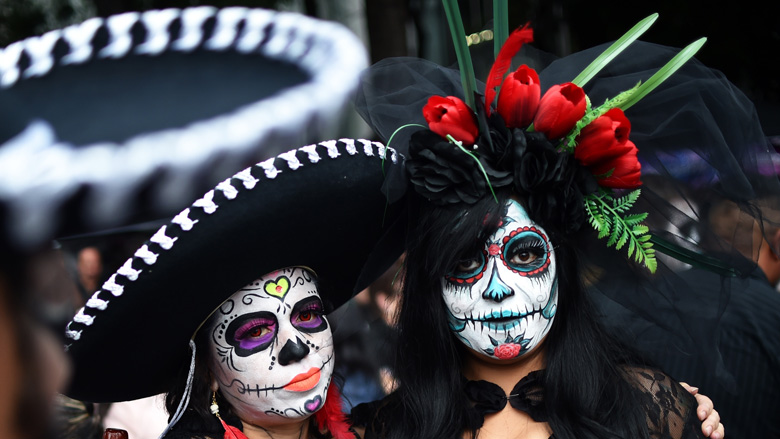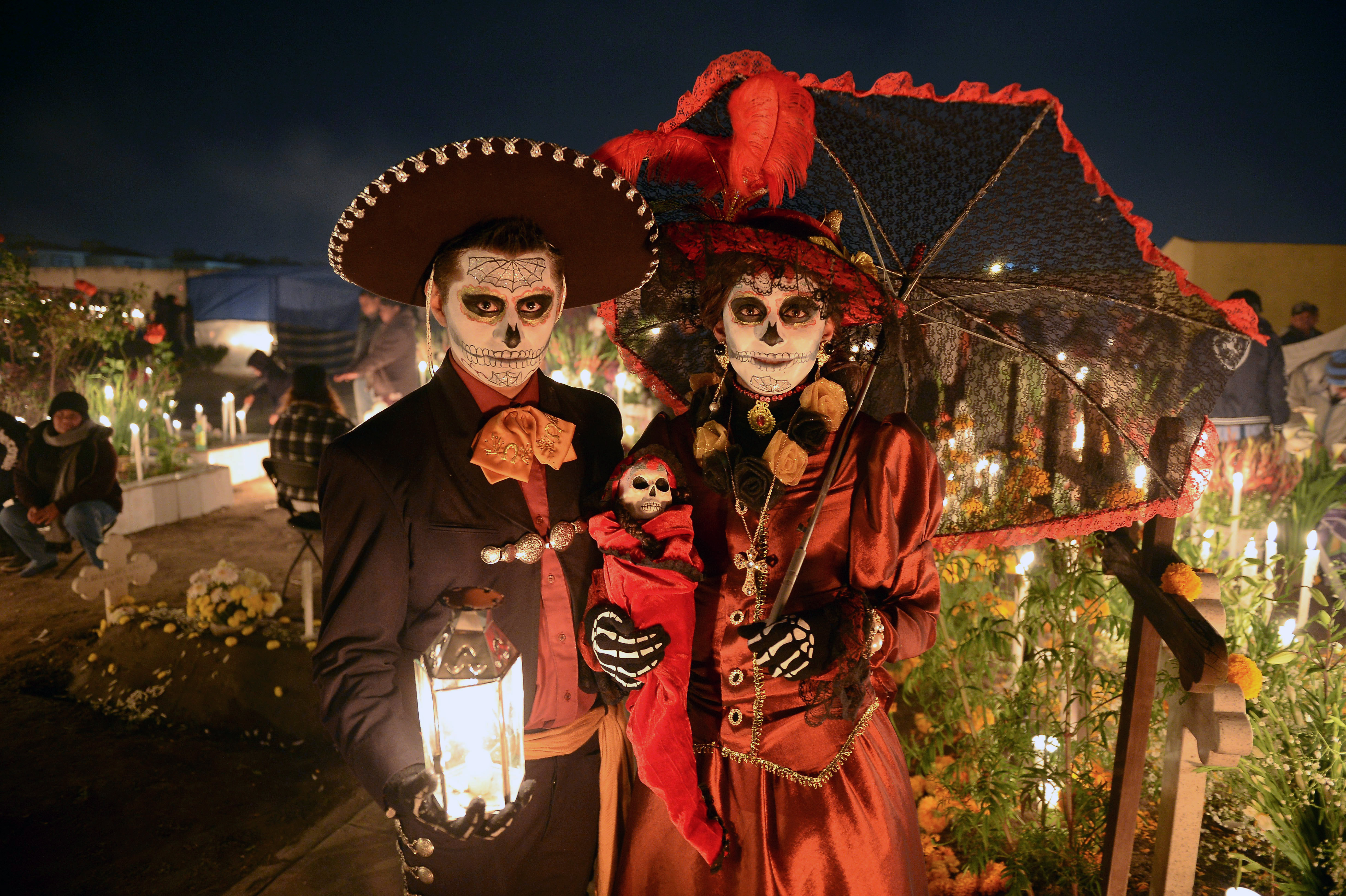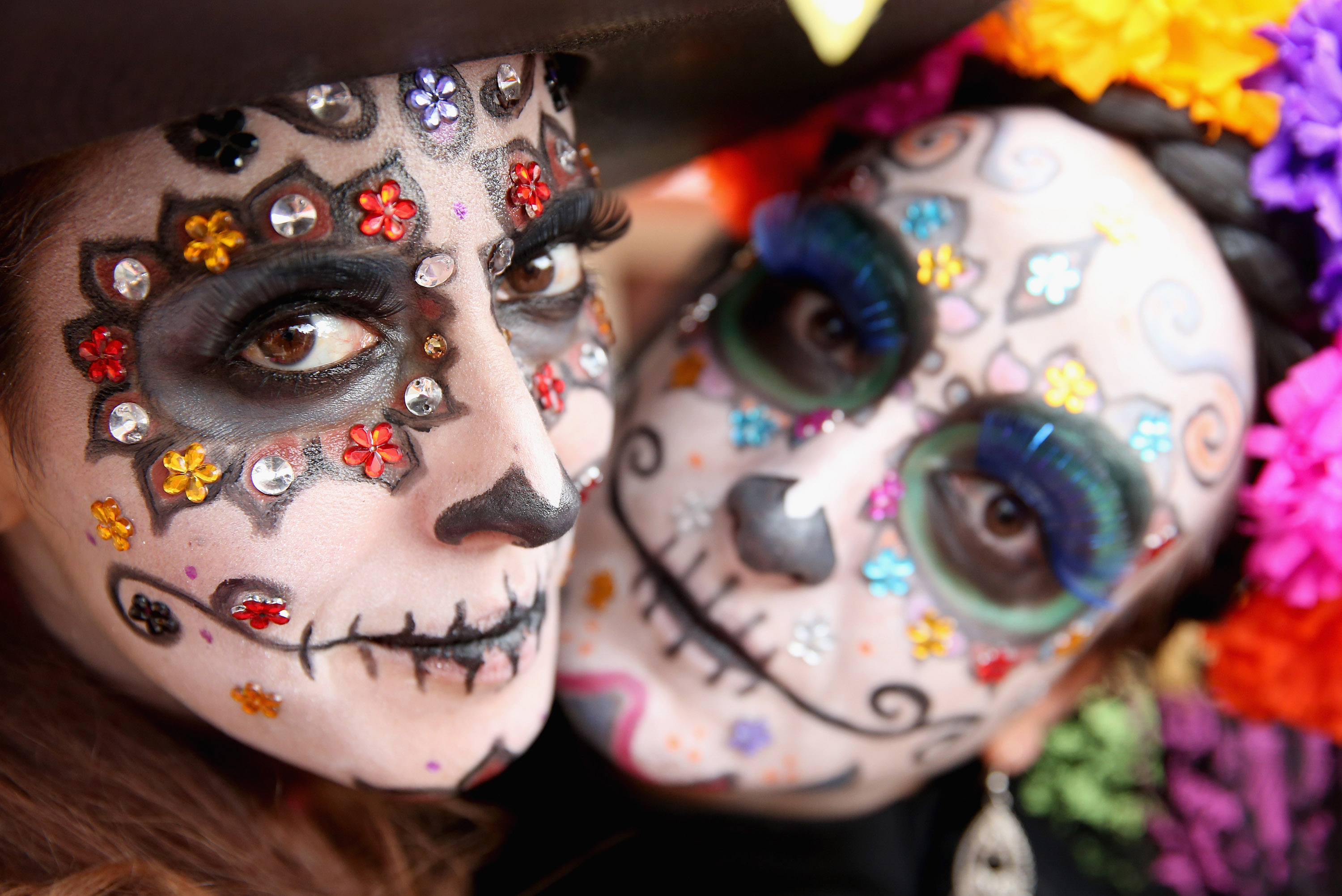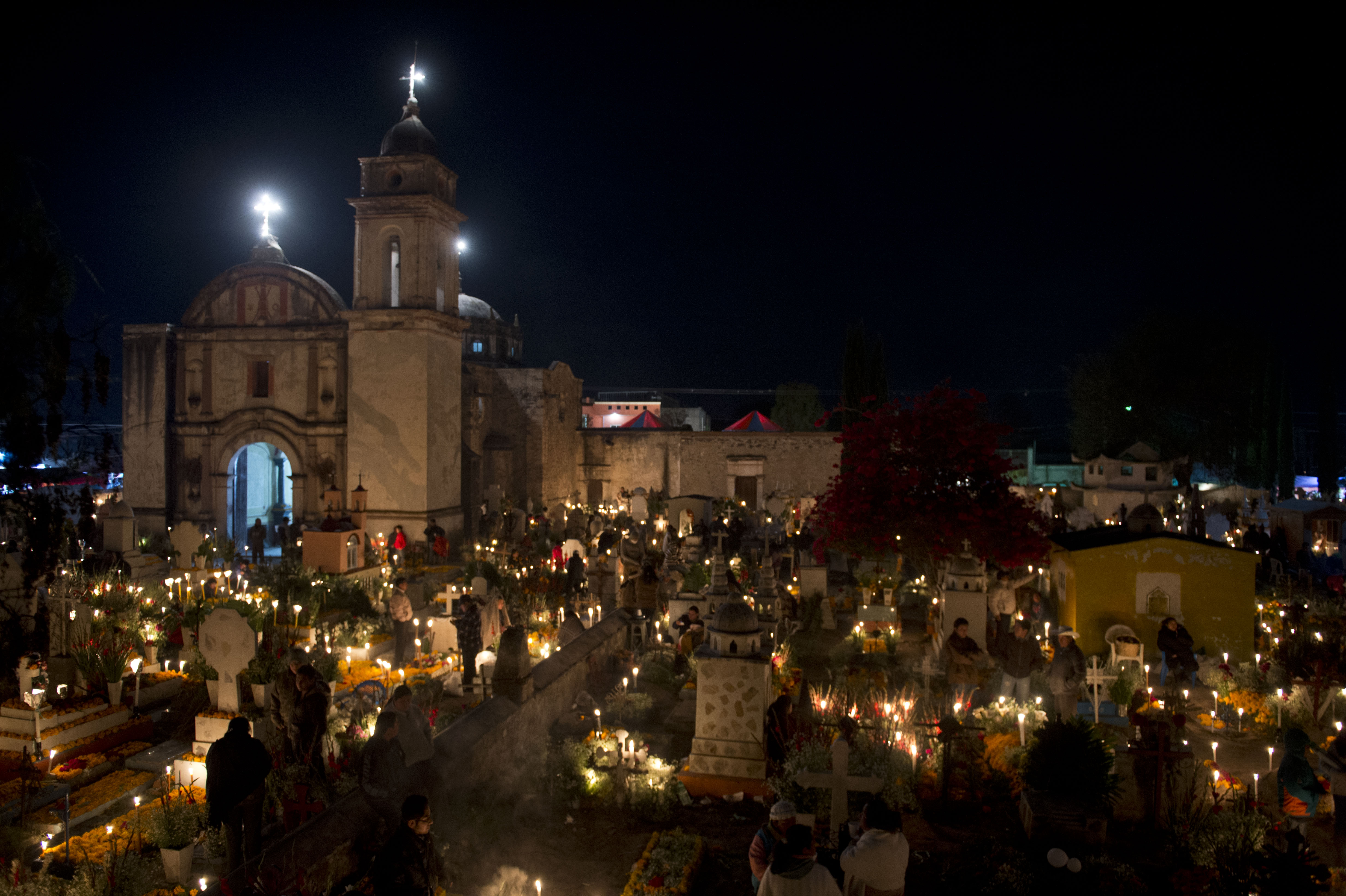
Getty - Revelers taking part in the 2018 Day of the Dead parade in Mexico City on October 21.
The Mexican holiday Dia de los Muertos, or Day of the Dead, is being celebrated on November 2, 2018, with a Google Doodle.
“The Day of the Dead, which dates back to Pre-Columbian times, honors the mysteries of life and death, through both celebration and reverence,” Google says. “Families prepare for the celebration far in advance, cleaning the house and decorating it with fragrant marigold flowers and intricate tissue-paper cutouts. Playful calacas and calaveras (skeletons and skulls), are usually seen in festive attire, enjoying (after)life to the fullest. Colorful ofrendas or altars are set up in many homes, surrounded by favorite food and drink, as well as photographs and cherished mementos, plus sweet Pan de Muertos and sugar skulls. Burning candles and incense is also customary to set the mood, evoke the spirit world, and serve as a reminder that death is just another part of life and that human connections will always endure.”
Here’s what you need to know about the Day of the Dead:
1. The Holiday Has Been Celebrated for More Than 3,000 Years in Mexico

A couple disguised as dead poses at San Jeronimo Chicahualco cemetery in Metepec, Mexico on November 2, 2013 during the commemoration of the Day of the Dead. (Getty)
The Day of the Dead tradition is rooted in Mexican culture and has been celebrated for thousands of years. It was first a part of the Aztec culture, but became mixed with Christian beliefs when the Spaniards came to Mexico, according to the Arizona Republic:
Unlike the Spaniards, who viewed death as the end of life, the natives viewed it as the continuation of life. Instead of fearing death, they embraced it. To them, life was a dream and only in death did they become truly awake. However, the Spaniards considered the ritual to be sacrilegious. They perceived the indigenous people to be barbaric and pagan.
In their attempts to convert them to Catholicism, the Spaniards tried to kill the ritual. But like the old Aztec spirits, the ritual refused to die. To make the ritual more Christian, the Spaniards moved it so it coincided with All Saints’ Day and All Souls’ Day (Nov. 1 and 2), which is when it is celebrated today.
According to the National Endowment for the Humanities, “The Aztec Festival of the Dead was originally a two-month celebration during which the fall harvest was celebrated, and figures of
‘death’ were personified as well as honored. The festival was presided over by Mictecacíhuatl, Goddess of the Dead and the Underworld, also known to the Aztecs as Mictlán. In the pre-Columbian belief system, Mictlán was not dark or macabre, but rather a peaceful realm where souls rested until the days of visiting the living, or los Días de los Muertos, arrived. Over the course of the festivities, participants place offerings for the dead in front of homemade altars, including special foods, traditional flowers, candles, photographs, and other offerings.”
According to Dallas Morning News contributor Pilar Zazueta, the meaning of the Day of the Dead in Mexico has changed in recent years.
“Today, the country is going through a dramatic wave of violence and impunity, and the Día de Muertos is acquiring a different meaning,” Zazueta writes. “Homicides and disappearances dominate foreign press coverage about Mexico. These are not exactly the kind of muertos that make people eager to visit the country or celebrate its traditions.”
Zazueta writes that public memorials to victims of violence have become more prevalent in Mexico, including a recent altar for Alessa Flores, a transgender activist:
Día de Muertos has never been a static ritual. It has the meaning that people give to it: spiritual, celebratory, but mostly challenging the status quo. In a context in which we all have counted thousands of victims of homicides and disappeared persons in Mexico, maybe there is nothing to celebrate.
But if it helps us to remember and publicly recognize the work and the life of people such as Alessa Flores, Día de Muertos might not be dead after all. Perhaps in the future, the ritual will reincorporate its satirical and playful roots, but for now this seems unlikely.
Others drew comparisons to the violence in negative reactions to the Mexico City parade.
“More than 100,000 dead: decapitated, disappeared, buried in clandestine graves, thrown in garbage dumps, reduced to ashes, drowned in sewage canals, dead by hanging in the public plaza … Why do with minimising what should give us all chills?” wrote Alma Delia Murillo in the online publication Sin Embargo, according to the Guardian.
2. Day of the Dead Traditions Include Skull Masks & Sugar Skulls
Those celebrating the holiday in Mexico wear skull masks, which are called calacas and dance to honor their deceased relatives, according to the Arizona Republic.
They also make sugar skulls, with the name of a deceased relative on the forehead, which are then eaten by a friend or family member, according to the newspaper.
According to National Geographic, “Assured that the dead would be insulted by mourning or sadness, Dia de los Muertos celebrates the lives of the deceased with food, drink, parties, and activities the dead enjoyed in life. Dia de los Muertos recognizes death as a natural part of the human experience, a continuum with birth, childhood, and growing up to become a contributing member of the community. On Dia de los Muertos, the dead are also a part of the community, awakened from their eternal sleep to share celebrations with their loved ones.”
Ofrendas, or offerings, to bring the deceased relatives back for a visit are a major part of the holiday, according to NPR.
“Among the most popular food offerings are tamales — delicious little packages of masa, or dough made from corn flour, wrapped in aromatic leaves, usually corn husks or banana leaves, and steam cooked. There are hundreds and hundreds of types of tamales, which can come with sweet or savory fillings such as beef, pork, chicken or cheese,” NPR says.
3. Mexico City Held a Day of the Dead Parade for the First Time in 2016, Drawing on James Bond for Inspiration

Girls in facepaint in Real del Monte on the ‘Day of the Dead’ on November 2, 2014 in Hidalgo, Mexico.(Getty)
Dia de los Muertos, or Day of the Dead, is celebrated on November 2. The holiday is included in the days of the dead, along with Halloween and All Saint’s Day. It is also often connected with the Catholic holiday of All Soul’s Day.
“The days of the dead are truly a celebration of life,” according to a University of New Mexico website about the holiday. “When children dance with caricatures of death, eat skull sugar molds and learn to respect that life is brief, they learn there is a circle to life and to not fear death and then are free to enjoy and appreciate every moment.”
Mexico City held a parade on the Day of the Dead for the first time in 2016, according to People. More than 100,000 people attended the October 29, 2016, event.
https://www.instagram.com/p/BMKuKeOA_Ku/
“Day of the Dead is always something in Mexico City that is celebrated, though in a more serious way,” Enrique de la Madrid, the country’s tourism secretary, told the Guardian. “It’s a deeply rooted tradition in Mexico, but what we decided to do is a festival.”
The parade was actually inspired by the latest James Bond film, Spectre, which included a scene where Bond chased a villain through a Day of the Dead festival, officials told the Guardian.
Not everyone was happy about it.
“This is a cheap stunt,” tweeted Esteban Illades, editor of the magazine Nexos, according to the Guardian. “They film James Bond here and now we have the ‘traditional Day of the Dead parade’. Let’s see what happens when (the mayor) finishes reading The Da Vinci Code.”
4. Families Places Photos of Their Deceased Family Members on Their Altar & Visit Their Graves

People visit a cemetery in Tlacotepec, Puebla State, Mexico on November 2, 2012 during the commemoration of Mexico’s Day of the Dead. (Getty)
Families in Mexico “invite” their deceased relatives to return to the home for a visit on Day of the Dead, by placing photographs of their loved ones on altars, and offering flowers to them, according to the National Endowment for the Humanities.
“Extended families will often gather in cemeteries on the eve of November 2nd, el Día de los Muertos, and congregate at the gravesite of a deceased loved one to hold a commemorative feast. The family may keep a night-long vigil by eating the foods they have made in preparation for the celebration, visiting with each other, and praying for all the members of the extended family, both living and dead,” the NEH website says.
5. Mexican Immigrants Have Brought the Day of the Dead Traditions to the United States
The Day of the Dead holiday is also celebrated in the United States, especially in cities with large populations of people with Mexican ancestry, and parts of Latin America.
Families often build altars in their homes to dedicate to their deceased loved ones, surrounding them with flowers, food and pictures. They also light candles next to the altars. According to the Associated Press, Day of the Dead celebrations are growing across the U.S. Major celebrations are held each year in Texas, New Mexico, California and many other areas.
Barbara Acosta de Ruiz said she told The Press Enterprise she grew up celebrating the holiday in Michoacan, Mexico, and brought the tradition with her to Perris, California.
“For us, they haven’t died. They just got ahead of us,” Acosta told the newspaper about her deceased relatives. “One day, we’re going to reunite.”
In Hollywood, a large celebration has been held at the Hollywood Forever Cemetery for the past 17 years.
“The dead and the living come together this night,” Tyler Cassity, the president and owner of Hollywood Forever, told Fox News Latino. “And the veil between the living and the dead is lifted.”
Cassity said about 30,000 people attend the celebration.
“This celebration has become bigger than all of us, it’s between one living soul and a dead one, and we want to give families that chance to be with the ones they have lost,” Cassity said.
At the University of Texas, the Latino fraternity Sigma Lambda Beta International, holds an annual festival, according to Fox News Latino.
“We celebrate Dia De Los Muertos with the community for a couple of reasons,” Bryan Tamayo, director of the event, “to provide Latinos who are away from home a way to celebrate this day, and to spread culture awareness.”
“This is a holiday that I am passionate about,” Tamayo said. “And my goal is to make others enjoy it.”
Versions of the holiday are also celebrated in Bolivia, Brazil, Ecuador and Guatemala.
